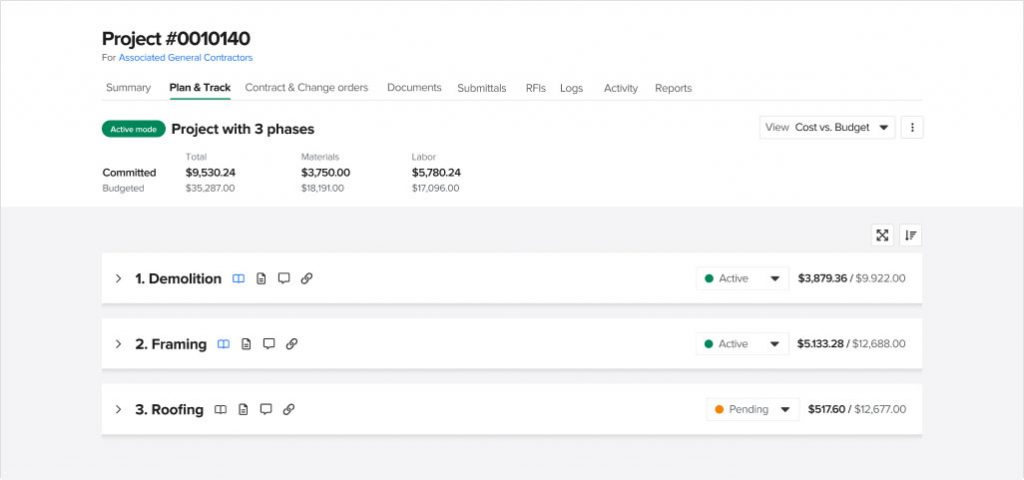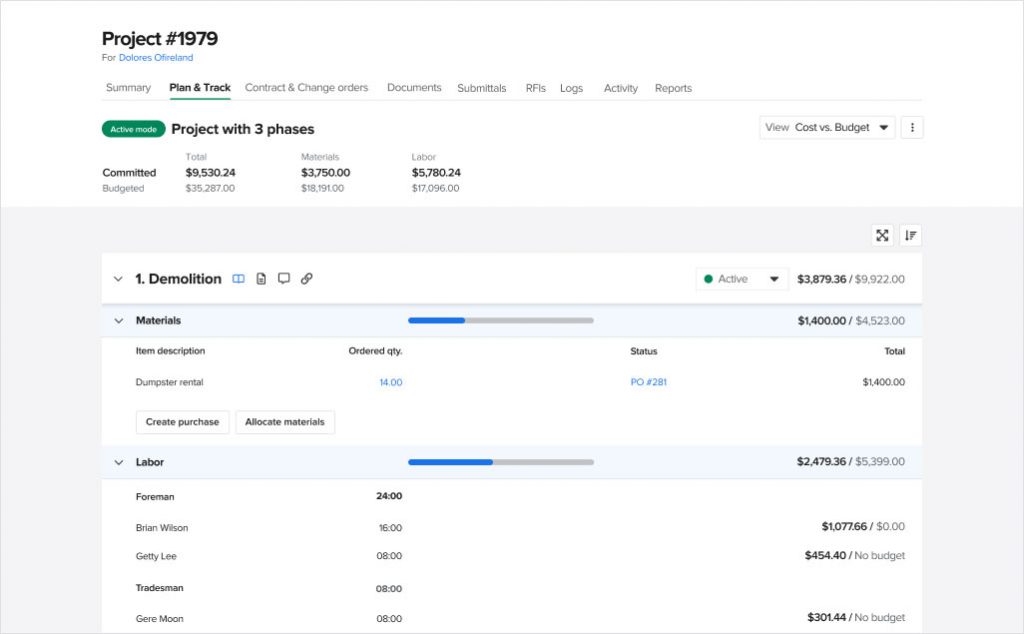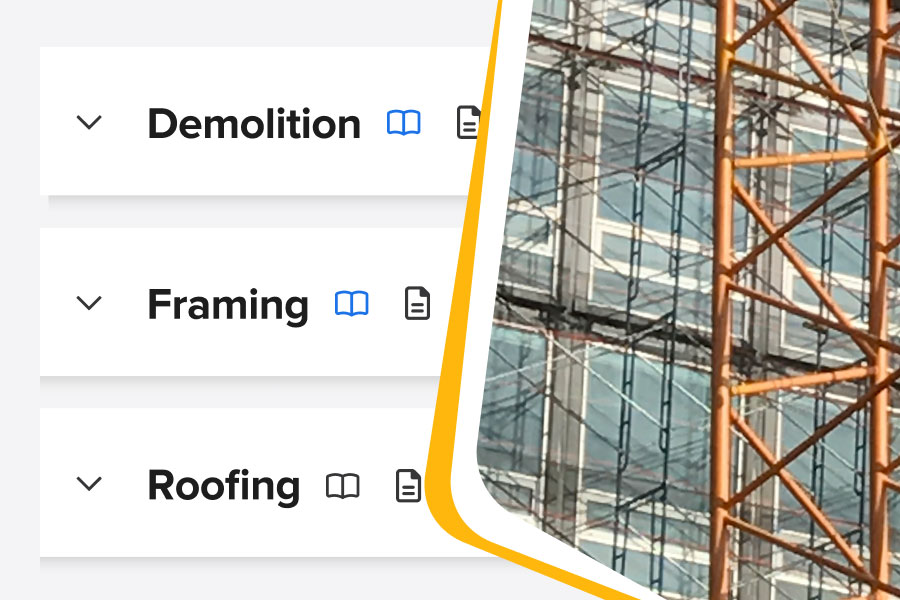Are you doing great work for happy customers, but finding that you still aren’t making money?
You’ve double-checked that your trim corners are tight and your punch list is ahead of schedule, but you’re still not generating a profit?
You’re not alone–nine out of every ten construction projects experience cost overruns.
Effective construction budget management is the solution.
In this article, we’ll show you how starting your projects with a budget can transform the way you plan, bid, and manage your jobs, helping you make more money in the process.
Expect to walk away with clear ideas on how construction project budgets can help you:
- Better organize and manage your projects
- Create more accurate estimates and persuasive proposals
- Stay under budget and as a result more profitable
Construction budgets help you organize and manage projects
At Knowify, we recommend beginning every project with a budget. Doing so helps you plan the steps needed to complete the project, the amount of time each step will take, and the estimated costs for each step.
The best way to start your budget is by referencing a clear scope of work (SOW). If you’re working for a GC or project owner, they’ll likely give you a scope to that you’ll use to create your bid. If you’re working directly with a homeowner, or the project is a little more ambiguous, it might be on you to create the SOW based on what your experience tells you the job requires.
On a side note, if your project lacks a clear scope of work, that’s a major red flag. Clarify the SOW with the project owner and get it in writing before submitting a bid or going any further in the project.
With that said, you want a clear SOW, because it’ll give you insight into timelines and expected outcomes so you can make cost estimates and break down all of the materials, labor, and additional resources needed for the project.
Without those details, you can’t effectively budget or bid on the job. It’s like starting a road trip without knowing the destination. You might get there eventually, but the route you take won’t be as efficient as it could be.
With a clear SOW, you can start to build out a project budget that includes major costs and timelines. The best way to do this is to split the entire job into phases or job stages. Start with the end in mind. What is the objective of this job? Then break out all the significant job stages that need to happen before you can achieve that objective.

For example, a plumbing contractor working on a new construction project might split their project into three phases:
- Groundwork / Site preparation
- Rough-in
- Trim out
Each of these phases encompasses multiple tasks spanning multiple days. With each phase detailed, you can now fill in the cost categories for each phase. Each phase should comprise all the major cost categories (labor, materials, equipment, subcontractor fees, and miscellaneous costs).
What teams are needed for the rough-in, and how long do they need? Do you need to rent any equipment for the groundwork? Running through this exercise ensures you’ve thought of every major cost for every significant phase of the job. In the process, you’ll have created an accurate line-item budget for every stage of a job.

By doing so, you’ll end up with a phase-by-phase project plan that tells you exactly what you need to do to deliver on the scope of work. But more importantly, it will tell you what you need to do to execute and remain profitable.
Construction budgeting software like Knowify dramatically simplifies the budgeting process. Check out the video below to see it in action.
In addition to simplifying processes, budgeting software like Knowify will save you hours of time on subsequent projects. It does this through the ability to save budgets as project templates that can be reused on as many projects as needed.
Moreover, you can save services in the catalog, which means you can break projects out into phases, such as site inspections or prep phases, in minutes. On top of that, you can add resources to each project, such as individual team members, their rates, and equipment, making phase-based budgeting even easier.
If you need a custom proposal or RFI template, Knowify allows you to create exactly what you need to effectively communicate with clients. This cuts down on time and prevents errors from sneaking into budgets.
Knowify | Construction budgeting that maximizes profit and minimizes risk
Effortlessly manage your next project's budget and timeline using our free, customizable construction budget template
They help you create accurate estimates and proposals
If you spend the time to craft a comprehensive budget from the get-go, you’ll make creating estimates and proposals that much easier.
With accurate cost projections down to the task, all you need to do to create a client-facing estimate is add your markup. Because you’re basing your estimate on an accurate understanding of projected costs taken from the SOW, the project is much more likely to be profitable when all is said and done.
Additionally, your proposal will likely be more competitive than if you simply relied on an educated guess for the project’s costs. You’ll know how to fine-tune your markup to cover overhead, project costs, and profit without any additional fluff that could make your bid look unnecessarily high compared to your competitors.
One of the most common mistakes that construction business owners make is underestimating or overestimating the cost of a project. This usually happens when you’re not considering all the factors that can impact the cost of a project. Doing your research and starting with a budget keeps this from happening.
Turning your estimate into a proposal
Simply creating a budget is not enough to secure a project bid. It’s important to also turn your estimate into a competitive proposal that will impress clients and set your company apart from the competition.
Knowify understands the importance of maintaining a professional image when sending out proposals to potential customers. That’s why we recommended that you use a platform that offers various customization options to help you create branded and polished proposals with logos, terms and conditions, and contract details ensuring every proposal reflects your professionalism.
We also advise that you include attachments where necessary, such as drawings and references. It’s also important to use tools that make life easier for your clients. Your construction project management software should allow you to send your proposal and other documents through email. Even better if the proposal is e-signable. This allows for a seamless and secure electronic signature process that helps keep projects moving forward.
In addition, you’ll want to set up automated notifications so you can track your proposal and stay on top of open bids. Furthermore, automated reminders ensure that your proposals do not get lost, saving you from missing important opportunities.
Knowify | Create and send proposals in 60 seconds or less
With Knowify, you can quickly markup your project budget and convert it into a customized proposal in minutes. Read more
They help you keep projects on-budget
While starting a project with a detailed budget is important, the most impactful thing you can do is continuously track costs against your budget as a job progresses.
Your budget is a living document that you’ll need to update and monitor as a job moves through each phase. Checking costs at the end of the project isn’t enough here. You’ll need to track actual costs against your budget on a regular basis. For example, if you see that labor costs are higher than you expected, you can investigate and take corrective actions to reduce future costs from continuing to snowball and save your bottom line for the project.
When you combine budget-first project execution with a powerful construction job costing software like Knowify, you’ll have the ability to track costs in real-time.
Real-time tracking means you’ll have an influx of budget data at your disposal. This allows you to identify any variance between the budgeted amounts and the actual expenses, enabling you to take early corrective action to avoid any potential budget overruns.
Cost tracking in Knowify
For example, if a particular project exceeds the budget due to unforeseen expenses or changes in scope, business owners can discuss these issues with the client and find ways to reduce costs or negotiate a higher budget. Taking early corrective action can prevent budget overruns from spiraling out of control and ultimately improve profitability.
Work in Progress reports (WIP)
WIP reports are an essential piece of the puzzle, not only to track billing accuracy but also to identify potential financial risks for involved parties such as bankers, lenders, and project owners. By regularly referring to WIP reports, contractors can accurately monitor their progress and avoid cashflow issues caused by underbilling — such as completing 75% of a phase but only billing for 50%, for example.
Underbilling can also artificially inflate reported revenue, and overbilling–billing for more work than has been completed – can create costly errors and lead to financial complications if not properly managed. Again you’ll need to shy away from manual WIP reporting and lean on the capabilities of construction management software.
Manual WIP reporting is not only time-consuming but is more prone to error due to the complex nature of WIP reports. Knowify’s automated WIP reporting feature allows contractors to track job billing and maintain an accurate view of their profitability in one easy-to-use platform.
In addition, you can create WIP reports in minutes instead of the hours it would take to create on by hand.
See Knowify’s robust reporting platform in action
Construction budgeting pro tips
There are a few common mistakes that can turn even the most comprehensive of budgets ineffective. Below we compiled four tips to ensure your budgets are as foolproof as possible.
1. Use job costing data if you have it
Through the use of job costing software, construction business owners can gain valuable insights into their project financials and make informed decisions that improve the profitability of future projects.
For example, if materials costs have been consistently rising, you can adjust cost estimates accordingly. Additionally, job costing data can help identify labor inefficiencies or cost overruns in materials. More than likely, labor costing will be eating into your bottom line. Use job costing to understand where and why labor costs are higher than expected.
Job costing styles in Knowify
In addition, accurate job costing data gives you an advantage when bidding or negotiating with clients. This detailed information on project costs allows you to confidently bid on projects and gives you more ammo when negotiating favorable contracts since you’ll be able to clearly showcase how certain costs will impact project execution or costs on your end.
If you need help getting started, begin with tracking and recording your actual costs against what you budgeted before a project. From there, look to see where and why costs went over budget. Was labor costs the culprit? Did an influx of change orders wreak havoc on your original budget? Did your team take longer than you expected? Find the answers to these questions and factor in those details when making your next budget.
For more help with setting up a job costing process, check out our complete guide to construction job costing.
2. Don’t forget labor burden
Labor burden is the total cost for a company to employ a worker. It includes wages, as well as other costs like payroll taxes, health insurance, training, and paid time off.
Labor burden is typically expressed as a percentage of base wages. All combined, these costs can quickly add up. Resulting in an employee whose actual cost to the company is far beyond their hourly wage.
Failure to account for labor burden will create the illusion of profitability while silently draining your bank account. It is a “hidden cost” that must be brought to light early and often. It affects how you price jobs, estimate, bid, schedule, etc. Calculating the labor burden for each employee is a crucial exercise that all successful construction companies must do.
Include the full eco-system of costs:
- Property
- Professional fees and services
- Materials
- Labor
- Equipment and tools
- Project management
- Insurance and bonds
- Utilities and taxes
- Contingency
3. Mishandling change orders
Utilizing change orders is crucial for managing projects effectively. In order to ensure smooth progress, it is essential to follow these key steps:
- Utilize change orders when your client requests scope changes during project execution.
- Obtain proper approval before proceeding with any additional work.
- If you weren’t the one who issued the order, be sure you have a conversation with your GC or project owner to identify how your budget will be impacted and how that might influence project execution.
- Incorporate the changes into your budget to accurately track budget vs. actuals and facilitate proper invoicing.
See how Knowify simplifies creating and managing change orders
Mismanaged change orders can significantly disrupt project budgets. Therefore, it is important to proactively minimize the number of change orders during construction. However, there are times when change orders are unavoidable. In such cases, it is crucial to have a comprehensive budget that accounts for all potential expenses.
This will allow for flexibility in adjusting the budget and accurately predicting the impact on the overall numbers. If change orders are initiated by the general contractor or project owner, it is imperative to thoroughly discuss their impact on the budget and cash flow requirements.
4. Using spreadsheets
Spreadsheets or pen and paper tracking just won’t cut it in today’s industry. As you progress to managing complex or multiple projects, the need for speed, accuracy, and organization renders those tools obsolete. Calculating a WIP report by hand vs. a tool that does it automatically is a night and day difference.
Using dedicated budgeting software like Knowify will save you hours of time when it comes to creating, tracking, adjusting, and analyzing budgets. Meaning you’ll have more time to focus on your business and less time buried in paperwork.
Knowify | Organized projects that stay on budget
Are you still using spreadsheets? Revolutionize your project planning with powerful construction budgeting software. Know exactly where you stand on any project and grow your business with confidence through profit-enhancing budgeting.
Schedule a demo with Knowify today to see how you can ensure organized and profitable projects.
